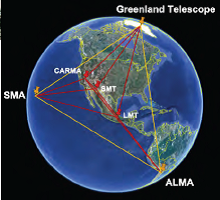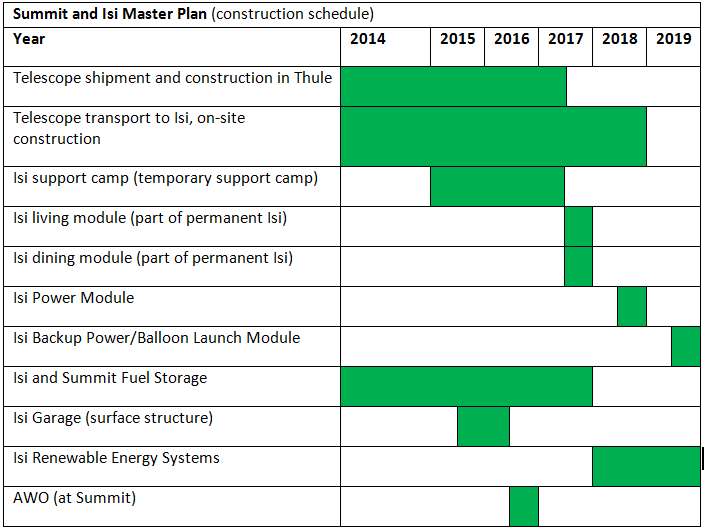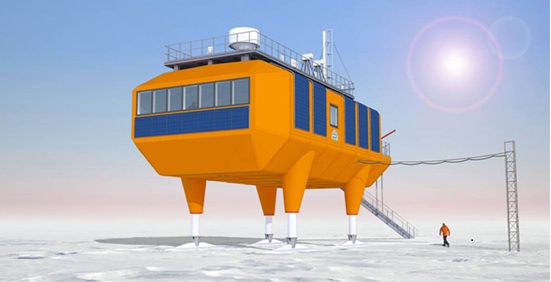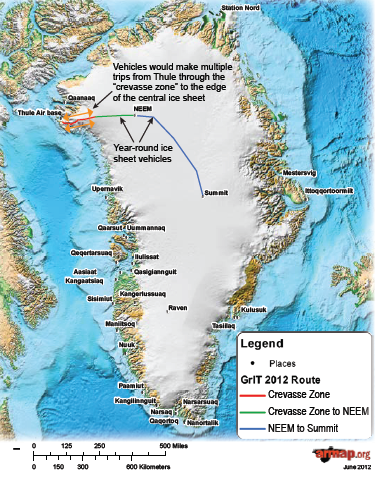Summit Station Developments and the new Isi Station
Major changes in facilities and operational models are underway for Summit Station and the surrounding area. Ultimately, the plan proposes that there will be two active research sites located roughly three miles apart. Summit Station will transition to Summit Observatory and retain the clean air and clean snow research and other projects coupled with the GISP2 ice core. The second site will house the primary station with power generation, living quarters, laboratories, and other infrastructure to support research projects that are not coupled to the GISP2 ice core. Two main drivers are pushing these changes. First, the requirement to maintain clean environmental conditions for pristine and highly unique atmospheric measurements continues to be a primary scientific objective. Summit Observatory will continue to be a pristine, low-impact observational facility for atmospheric measurements and those projects requiring pristine snow connected to the atmospheric records. The second driver, a major telescope project – a joint effort between the Smithsonian Astrophysical Observatory (SAO), the Academia Sinica Institute of Astronomy and Astrophysics (ASIAA) of Taiwan and others – has identified the Summit area as a desirable location to install a 12-meter radio telescope, due to the high, dry conditions at the summit of the Greenland Ice Sheet. The Greenland Telescope will be part of a millimeter wave VLBI (very long baseline interferometry) network, and will take part in the Event Horizon Telescope project, which will consist of a global array of radio telescopes, as well as performing astronomical observations as a standalone telescope. The most important feature of the Greenland Telescope is its far northern location, which provides long north-south baselines for mm-wave VLBI observations in conjunction with telescopes in Hawaii, Chile, and other US and European mm-wave telescopes. This will enable the highest resolution astronomical observations of northern sky targets. The goal of the project is to image a super-massive black hole (SMBH) in the Galaxy M87. Summit’s low water vapor, low temperature, high altitude, and northern location as it relates to the other telescopes in the array make it an ideal site for the radio telescope. Plans are currently underway to install the telescope at a location north of Summit. All flight operations and most power generation will be conducted at the new facility. The development of renewable energy sources and building efficiency will continue to be a priority for both sites.

The new station, pending Greenlandic approval of NSF and SAO permit applications, will be called Isi, which is Greenlandic for “Eye” and was chosen in concert with the Government of Greenland. It will be located 3 miles north of the Summit Station site along the existing skiway. The purpose of the new location will be manifold. Initial development is in support of the ASIAA-Smithsonian telescope project and will be funded jointly by the telescope partners and NSF commensurate with the requirements of each. New science projects not requiring ‘pristine’ snow will be based out of Isi as will the station crew. Current plans call for construction of a telescope/station redevelopment support camp at the new site starting in approx. 2016 to be completed in approx. 2018, contingent upon available funds. Concurrent activities in Thule will be undertaken during the same period to enhance the Greenland Inland Traverse capabilities and construct modular components of the new station and telescope. The telescope is planned for delivery via the GrIT traverse by ~2018 and to be operational by the end of the season in which it is delivered. Construction of the Isi Living Module and Dining Module, the main berthing facilities of the new camp will begin in ~2016, with a planned completion date of ~2017. In addition to the living and dining modules, Isi Station will consist of a power module, a backup power and balloon launch module, fuel storage, and a garage. Extensive use of renewable energy (RE) systems is planned, expanding on efforts currently underway at the existing Summit Station to use photovoltaic (PV) and passive solar systems. The summer population at the new Isi Station is predicted to stay similar to the current summer population at Summit, which can fluctuate between 20-50 people. The winter population of Isi Station is predicted to double from the current 5 member staff at Summit to ~10-20 station members, with many of those supporting telescope operations. Future populations may be impacted by other science, as the physics community interest grows in the suitability of the sky conditions above Isi for other telescopes, as well as recently confirmed favorable conditions of the thick ice sheet for high energy neutrino detection experiments.

A note on dates: All dates are approximate and depend on actual funding.

The Summit Observatory will get one new building, the Atmospheric Watch Observatory (AWO) to replace the Temporary Atmospheric Watch Observatory(TAWO) in 2016. This building incorporates design elements from the British Antarctica Halley VI station and other state-of-the –art capabilities, in particular the leg lifting system to maintain the building above the snow. All other surface-based buildings will be removed and/or relocated to Isi with the exception of the Big House. The Big House will be reconfigured as an emergency crew shelter and remain at Summit Observatory. The crew will primarily live at Isi and commute daily using electric vehicles via an established route.
Renewable Energy Projects
Isi Station will continue the deployment of renewable energy (RE) systems that have been established and successfully tested at Summit Station. Currently, the Summit Tower of Power PV system has generated 4MWh of energy production after being operational for one year. This energy production correlates to over 300 gallons of diesel fuel. The Big House micro-inverter PV array, which is currently made up of a six panel array vs. 24 panels for the Tower of Power, produced 1.44 MWh of energy in its first year, with a higher energy density than the Tower due to all 6 panels on the Big House being oriented directly south. The power generation data from both PV systems greatly informs strategies for deploying future high latitude solar systems.
Electric vehicles have also been tested and developed at Summit Station, including a range of electric buggies and a series of electric snowmobiles representing the winners of the annual Clean Snowmobile Contest (CSC) contest.
Development of a GrIT Science Traverse Facility

Along with Isi Station and Summit Observatory developments, the Greenland Inland Traverse (GrIT) will maximize its capability with a split fleet option. The split-fleet maximizes the short window of time that the crevasse zone can be crossed, with one fleet shuttling cargo and vehicles through the crevasse zone in March-April and another fleet operating on the ice sheet hauling loads to Summit/Isi and other locations through the duration of the summer season. Of chief interest for science groups is the development of a mobile science traverse facility, which will allow individual science groups access to interior points of the ice sheet beyond Summit and Isi.
